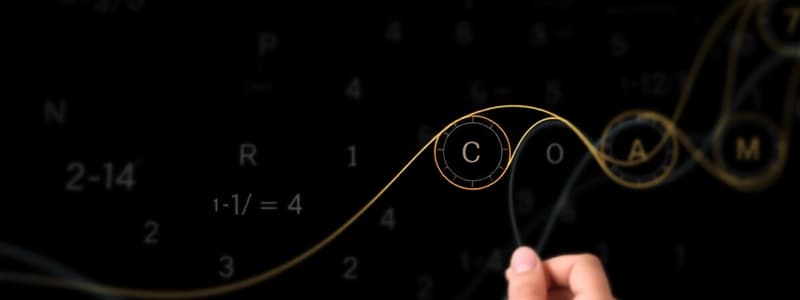Podcast
Questions and Answers
What is the Fibonacci Sequence primarily known for?
What is the Fibonacci Sequence primarily known for?
- A series that lists the first ten natural numbers
- A series where each number is doubled from the previous one
- A sequence representing prime numbers only
- A sequence in which each number is the sum of the two preceding numbers (correct)
How can mathematics be advantageous in understanding natural phenomena?
How can mathematics be advantageous in understanding natural phenomena?
- By focusing solely on arithmetic calculations
- By predicting behaviors such as the sun's movement and weather patterns (correct)
- By creating formulas that have no real-world applications
- By providing random guesses about environmental changes
Which of the following best describes the Golden Ratio?
Which of the following best describes the Golden Ratio?
- It's a minimal measurement in art and architecture
- It's an algebraic term used exclusively in geometry
- It's the ratio between successive Fibonacci numbers, approximately equal to 1.618 (correct)
- It's a statistical measure used to analyze population trends
What role does algebra play in population control?
What role does algebra play in population control?
What is the Fibonacci Spiral derived from?
What is the Fibonacci Spiral derived from?
Why is it essential to have clear definitions in mathematics?
Why is it essential to have clear definitions in mathematics?
What does the expression of mathematics through symbols allow?
What does the expression of mathematics through symbols allow?
Which of the following best describes what patterns in nature refer to?
Which of the following best describes what patterns in nature refer to?
What is the primary characteristic of mathematics that enables it to express complex ideas succinctly?
What is the primary characteristic of mathematics that enables it to express complex ideas succinctly?
What type of set contains no elements?
What type of set contains no elements?
In mathematics, what does the symbol ∀ represent?
In mathematics, what does the symbol ∀ represent?
Which of the following best describes a binary operation?
Which of the following best describes a binary operation?
What best defines a proposition in logic?
What best defines a proposition in logic?
Which of the following expressions correctly represents the sum of two consecutive numbers equaling 31?
Which of the following expressions correctly represents the sum of two consecutive numbers equaling 31?
What is the first step in Polya’s Four-Step Plan?
What is the first step in Polya’s Four-Step Plan?
What is the relationship that a reflexive relation exhibits?
What is the relationship that a reflexive relation exhibits?
Which logical connective is NOT a type used in compound propositions?
Which logical connective is NOT a type used in compound propositions?
What is the outcome of operations on sets such as intersection?
What is the outcome of operations on sets such as intersection?
What is one method to count the number of handshakes among 10 people?
What is one method to count the number of handshakes among 10 people?
What type of reasoning is defined as drawing conclusions from specific examples?
What type of reasoning is defined as drawing conclusions from specific examples?
Which of the following is an example of deductive reasoning?
Which of the following is an example of deductive reasoning?
In the context of problem-solving strategies, what does 'working backwards' involve?
In the context of problem-solving strategies, what does 'working backwards' involve?
Which statement correctly describes quantifiers?
Which statement correctly describes quantifiers?
What is the objective of using statistical tools in mathematics?
What is the objective of using statistical tools in mathematics?
What is the definition of variance?
What is the definition of variance?
Which of the following sampling methods ensures all members have an equal chance of selection?
Which of the following sampling methods ensures all members have an equal chance of selection?
What does a box plot primarily illustrate in a dataset?
What does a box plot primarily illustrate in a dataset?
What type of error occurs when a true null hypothesis is rejected?
What type of error occurs when a true null hypothesis is rejected?
Which type of test examines if there is a difference in either direction between two means?
Which type of test examines if there is a difference in either direction between two means?
What does the empirical rule state concerning a normal distribution?
What does the empirical rule state concerning a normal distribution?
What is the primary purpose of exploratory data analysis (EDA)?
What is the primary purpose of exploratory data analysis (EDA)?
Which graphical method is best suited for displaying the distribution of a categorical variable?
Which graphical method is best suited for displaying the distribution of a categorical variable?
What is a fundamental component of the scientific method?
What is a fundamental component of the scientific method?
Which of the following describes the concept of fallibility in science?
Which of the following describes the concept of fallibility in science?
What attitude can help in advancing scientific inquiry?
What attitude can help in advancing scientific inquiry?
What is meant by the term 'dependent variable' in an experiment?
What is meant by the term 'dependent variable' in an experiment?
Which of the following statements best describes the term 'empirical' in the context of science?
Which of the following statements best describes the term 'empirical' in the context of science?
What is the 'mean' in the context of descriptive statistics?
What is the 'mean' in the context of descriptive statistics?
Which of the following best describes the uncertainty inherent in scientific findings?
Which of the following best describes the uncertainty inherent in scientific findings?
What role does caution play in interpreting scientific data?
What role does caution play in interpreting scientific data?
Flashcards are hidden until you start studying
Study Notes
What is Mathematics
- Mathematics is the study of relationships and patterns through symbols, numbers, letters, and diagrams.
Mathematics in Nature
- Mathematics is used to predict natural phenomena such as the sun's movement and weather forecasts.
- Algebra helps predict population growth, which can inform policy decisions.
- The Fibonacci Sequence appears in nature such as in the growth of rabbit populations and in plant patterns.
- The Golden Ratio, derived from the Fibonacci Sequence, is found in architecture, art, and nature as a measure of beauty and harmony.
Mathematics as a Language
- Mathematics is a language with its own vocabulary, grammar, and syntax.
- It allows for precise and concise expression of complex ideas.
- Mathematical language features include symbols, definitions, quantifiers, variables, and operations.
Problem Solving
- A problem is a situation requiring a solution, found in both theoretical and practical contexts.
- Polya's four-step plan for problem-solving includes understanding the problem, devising a plan, carrying out the plan, and looking back to verify the solution.
- Problem-solving strategies include logical reasoning, pattern recognition, working backwards, considering extreme cases, solving simpler problems, organizing data, making visual representations, accounting for all possibilities, intelligent guessing, and testing.
- Inductive reasoning draws general conclusions from specific examples or observations.
- Deductive reasoning uses general rules to reach specific conclusions.
Scientific Method
- Science is a method for acquiring knowledge about the natural world.
- The scientific method uses observation, experimentation, and a systematic approach to discover hidden knowledge.
- The scientific method is governed by established rules set by the scientific community.
- Characteristics of the scientific method include empirical evidence, objectivity, repeatability, fallibility, caution, and acceptance of uncertainty.
Statistics as a Tool
- Statistics is used to collect, organize, analyze, and interpret data to understand relationships between variables and draw conclusions.
- Statistics provides a means to make informed decisions based on data.
- Key concepts in statistics include variables, data types, measures of central tendency, measures of dispersion, and sampling methods.
- It includes both descriptive statistics (summarizing data) and inferential statistics (making predictions based on samples).
- Types of variables include quantitative (numerical) and qualitative (categorical).
- Quantitative variables can be discrete (countable) or continuous (measurable).
- Types of sampling include probability sampling (random selection) and nonprobability sampling (not everyone has an equal chance).
- Descriptive statistics include measures of central tendency (mean, median, mode) and measures of dispersion (range, variance, standard deviation).
- EDA techniques include bar charts, pie charts, line charts, histograms, and box plots.
- Inferential statistics involve hypothesis testing, where a null hypothesis (no effect or difference) is compared to an alternative hypothesis (effect or difference exists).
- Types of errors in hypothesis testing include Type I error (rejecting a true null hypothesis) and Type II error (accepting a false null hypothesis).
- The normal distribution is a bell-shaped curve that describes the distribution of data.
- The empirical rule states that 68% of values fall within 1 standard deviation from the mean, 95% within 2, and 99.7% within 3.
Studying That Suits You
Use AI to generate personalized quizzes and flashcards to suit your learning preferences.




